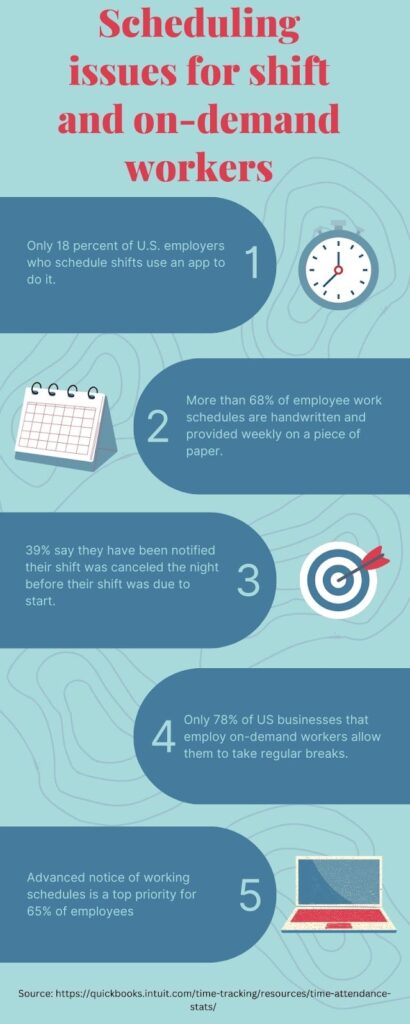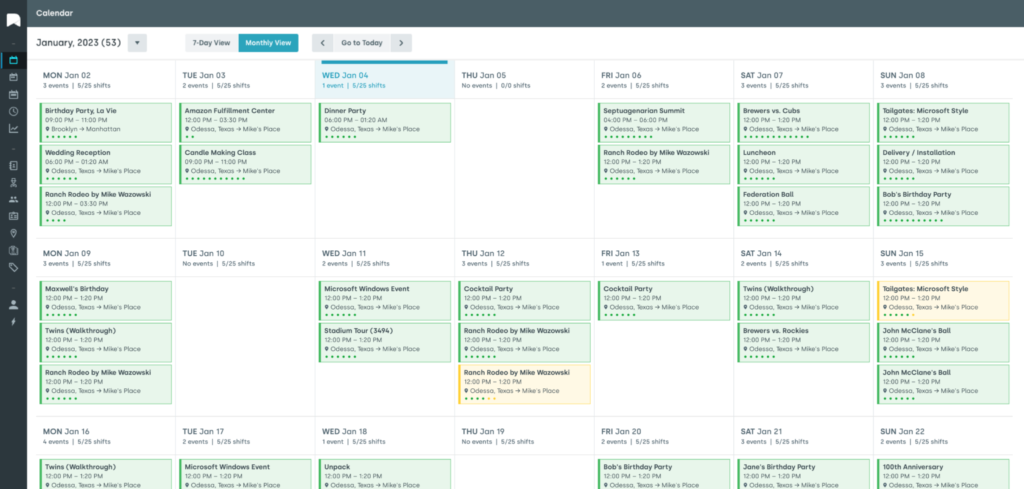Many businesses still use manual employee scheduling methods that are time intensive and prone to human error. Modern tools have evolved to serve the unique needs of businesses that rely on shift workers. Still, only 66% of U.S. workers who work for companies that track their time are hourly workers. Find out how automation can help businesses improve employee scheduling processes.
Current Methods of Employee Scheduling
These days, companies use a mix of manual processes and semi-automated tools. Many companies use several tools for employee scheduling, which complicates their operations.
Here are some statistics that illustrate the problem:

Top Scheduling Problems
1. Employee Turnover
You will always have employee turnover, but a high turnover rate can be a problem for any company. One of the ways you can reduce the turnover rate and increase retention is by managing the schedule efficiently. Over half of shift workers think they should have more notice when they are needed. A consistent schedule that considers employees’ needs may give them a reason to stay and improve their performance.
2. Employee Shortage
There are few things worse for employee morale than being spread too thin because of staff shortage. Productivity suffers when the business is understaffed, and customers are ultimately not given good service.
While the obvious solution is to hire new members, the budget may not always allow it. So how can you close staffing gaps? Scheduling optimization software from Nowsta can help organize your employees effectively.
3. Overscheduling
What is overscheduling? The term refers to keeping your workers on too many consecutive shifts without time off. You need to give your staff at least 12 hours off between shifts. But trying to keep each employee’s shifts separated manually can be challenging. Scheduling software can automate this process.
4. Disorganization
Manual processes cause disorganization when it comes to managing employees’ schedules. Assigning, changing, and reassigning tasks manually can lead to mistakes and misunderstandings.
5. No-Show Employees
No-call, no-show employees can disrupt the entire workflow of their team’s workday. While you cannot prevent no-shows, you can prevent the consequences for your company by simplifying the contact process for backup employees.
6. Hourly and On-Demand Workers
Managing the schedules of salaried employees is difficult enough, but if you add managing schedules of on-demand workers, temporary staff, and hourly employees, the problem can be compounded.
Most automated scheduling systems overlook integrating the schedules of on-demand workers. Nowsta is the only solution that allows you to manage salaried, hourly, temp, and on-demand workers in a single integrated system.
7. Vacations
Paid time off requests can be a nightmare to schedule without a scheduling system in place. Accommodating everyone while maintaining productivity can be a hassle for HR managers. The best solution is to abandon manual methods and let a software solution do the work. The system can schedule, monitor, and accommodate time-off requests.
How Automation Can Help Improve Employee Scheduling
Automated scheduling—a software solution that automates workflows in your business—can solve many of these challenges and improve performance. It creates an optimal schedule for all staff.
How Does Automated Scheduling Work?
The software uses AI to manage scheduling. For example, you need a server for the dinner shift next Saturday. You instruct the software to find a server. The software will sort through the information in the database, find an available candidate, and insert them into the schedule.
You save considerable time using the system when you need to find several employees for several shifts.
Benefits of Automated Scheduling
- Saves time: An automated system eliminates the need for time-consuming manual processes. You no longer need to sift through data to find the right worker. Create and manage a schedule with a couple of clicks. You can use the time you save for other core business activities.
- Increases profit: Overtime spending can easily destroy your budget. By automating the schedule, you instruct the AI to set overtime limits—from zero overtime to a designated number of hours.
- Helps in strategy planning: Robust scheduling software can help you use historical data to forecast future labor demands and apply the findings to new schedules.
- Simplifies tracking: An automated scheduling system can simplify time tracking for your employees. It also helps maintain compliance with labor laws regarding shift length, time off, and time between shifts.

Source: Nowsta
How Nowsta’s Solution Delivers a Better Scheduling Experience
Nowsta is a software platform that allows employers to manage permanent and temporary staff. Its features include scheduling, time-tracking, payroll integration, hiring, and payment. The platform allows employers to manage their staff and hire on-demand employees, all integrated into a single solution.
Some benefits of Nowsta’s workforce management for employers include AI-powered scheduling, intelligent time tracking, cross-platform messaging, and real-time notifications. Employees get a virtual bank account to receive instant wages, a digital paycheck, and a savings account. The platform also integrates with many major payroll solutions.
Nowsta is the only solution that also allows you to manage your flex, on-demand, shift, or temp workforce. Not only can you manage your existing workers, but you also search for and hire new employees via a built-in agency network. You can also centralize requisitions and get detailed labor analytics reports.
An automated scheduling system can solve many challenges of creating schedules for permanent and on-demand employees. It reduces workloads and allows organizations to focus on critical business activities.
Review Nowsta’s all-in-one solution to see how it enables you to manage and schedule hourly, shift, temp, and permanent workforces simultaneously.
Get in touch to request a demo and learn how to simplify your work scheduling with Nowsta.
